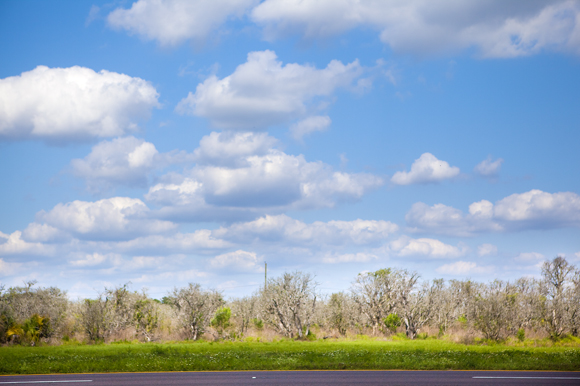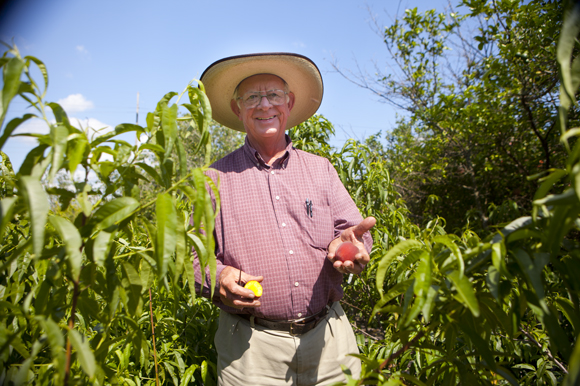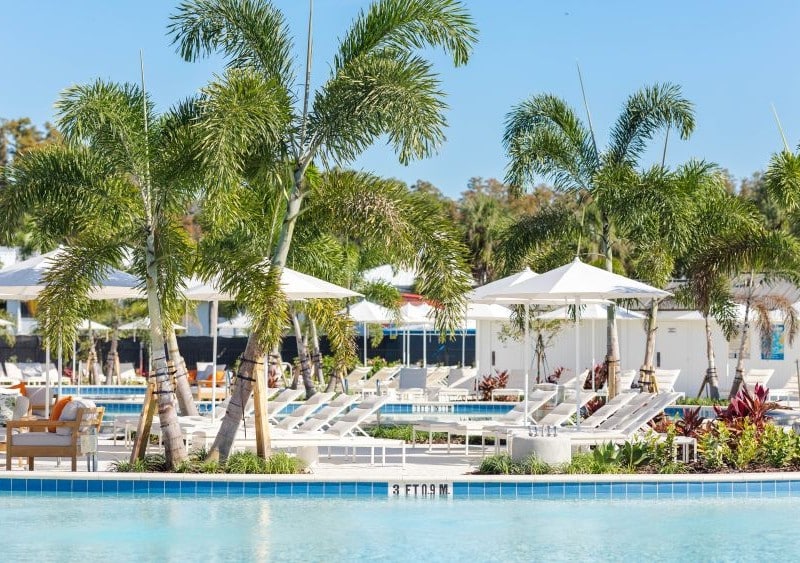Florida Citrus: Taming Wild Stock And Breeding A Legacy
Central Florida Is Ground Zero in the war against citrus greening, where the battle extends from historic groves to university laboratories, hi-tech strategies and the newest innovatons in crop research.
Martha Sue Hawkins Skinner and her husband, Richard Skinner, own some 20 acres across the road from her ancestors’ original homestead at what is now the intersection of James L. Redman Highway and Trapnell Road at the southern edge of Plant City in eastern Hillsborough County.
Until last year they operated a small 12-acre grove of early oranges, with a smattering of tangerines, grapefruit and succulent honeybell tangelos. That was before citrus greening came to visit with a vengeance and Skinner was forced to plow up some 2,000 trees — some descended from wild rootstock planted by Spanish explorers five centuries ago.
Most of it, though, was propagated from sour orange, the rootstock that for generations served as the foundation of Florida’s commercial citrus groves. Cuttings from Valencia, navels and other premium varieties were routinely grafted onto sour orange plants, which were resistant to freezes, salt and many pathogens that other rootstocks couldn’t tolerate in Florida.
But sour orange was not resistant to the tristeza virus, which many growers feared might kill off the industry a few years ago. The virus slowly choked off fruit production over a period of years, the farmers helpless to stop its march across the peninsula. As grove after grove succumbed to tristeza, some growers sold off their ruined tracts and got out of the business. Others, like Skinner, ripped out the ailing citrus and replanted using new rootstocks that appeared to resist the virus.
The industry seemed to have dodged another bullet. Then came citrus greening — also known as HLB disease — and now even the diehard growers, the fifth-generation citrus kings, face an enemy like no other.
“If it’s a hurricane, or even a devastating freeze, we know what to do with that: Replant at state-of-the-art,” says Mike Sparks, who heads the Florida Citrus Mutual.
But with this disease, there is no playbook, he says. Other pests and diseases might ruin the fruit, but HLB is a tree-killer that decimates the roots, the plant and also renders the fruit inedible. It is an insidious disease that takes months — and sometimes years — to detect. That is how it was able to infect so many groves in so many parts of the state before anyone knew it had been unleashed in Florida.
The vector itself — the Asian psyllid that spreads the bacteria from tree to tree as it feeds — has also proved hard to control. Unlike the Medfly, which state and federal agriculture officials seem to have conquered with the periodic release of sterile males to disrupt the flies’ ability to reproduce, the psyllid’s biology does not lend itself to such a remedy. Researchers are looking at other ways to beat back the bug, including a predator wasp with an appetite for Asian psyllids. But for the time being, localized spraying of pesticides and old-fashioned quarantines are the main weapons in the growers’ arsenal.
“We’ve made incremental progress in reducing psyllid numbers in the field, but the horse is already out of the barn so to speak,” says Harold Browning, who is leading a scientific charge to save a $9 billion industry.
Perhaps the hardest part for scientists to get a handle on is the actual microbe that infects the trees with HLB.
“It doesn’t act like most bacteria that attack systemically,” he says. “It stays in relatively low numbers and causes root damage long before you’d expect it to.”
Usually a disease like this will plug up the plant’s vascular system with massive amounts of bacteria, says Browning. Instead, advances in genetics research are helping the scientists understand that the bacteria cause the tree to plug itself in a defensive response.
“In there is the opportunity to reverse that signaling,” says Browning, CEO of the University of Florida’s Citrus Research Development & Foundation in Lake Alfred. “But there are so many pieces of the puzzle we can’t see.”
From The Lab To The Field
Crop science generally starts in a petri dish, and herein lays one of the greatest obstacles researchers have faced in tackling greening: No one has been able to culture the organism.
“That makes it really hard to work with,” says Browning. All things considered, “We’re fairly optimistic that things can’t get much worse than having HLB.”
Browning is equally optimistic that research will provide solutions — eventually.
“It’s not a matter of whether it can be stopped, but whether science can do it fast enough,” he says.
The war on greening is being fought on three scientific fronts: controlling the bug, killing the bacterium and supporting the tree’s ability to fight off HLB.
The most promising aspect is the development of rootstocks that can stand up to the disease, even if they become infected. Both the University of Florida and the USDA citrus breeding programs, some created over the past 20 years, have produced a number of promising candidates.
Most of these tolerant rootstocks have not been available for commercial use, and there is some risk in assuming widespread planting of them will work because researchers ideally want to observe field trials through the entire life cycle of the trees — a quarter century in the case of citrus.
Time is not on the industry’s side; that’s the real challenge, Browning says.
“We’re pushing hard on a group of scientists who are used to long-term data collection and all the hallmarks of science,” he says. “We’re asking them to make a decision long before they normally would; and we’re also working with the growers to see what their appetite is for larger-scale planting.”
Mixing Nutritional Cocktails
The industry is fighting back with a broad approach and a combination of strategies that attacks the insect and the bacteria in the groves, while buffering the trees with nutritional cocktails to help them survive the onslaught of HLB.
It’s a stop-gap measure to keep the groves and the industry functioning as long as possible as science races toward a cure, and one that only the largest operations can afford to try.
“The family groves used to be the industry,” says Skinner. “All of us with 10 and 25 acres have fallen by the wayside.”
But as the groves wither and the disease spreads, even some of the large growers are losing confidence that the battle can be won — and that concerns Browning.
“In a complex disease like this, you have to use all the tools available, and if you forsake any of these things, the disease wins. We’re trying to tell growers: ‘Do everything you can to keep these trees healthy. Don’t do half of what you should do, do all of it.’ “
The public investment in saving the industry is in the interest of all Floridians, not just those involved in growing, processing, transporting and marketing the fruit that put the state on the world map.
“If Floridians enjoy seeing rows of citrus trees maintaining open space; if they see it and place a value on it, there should be some public acceptance of trying to maintain the industry,” says Stephen Gran, director of the Hillsborough County Extension Service.
While scientists battle to save citrus, industry promoters like the growers’ associations in citrus-producing states, are aggressively pursuing a long-term federal remedy to fund research that would stay ahead of the curves, conducting field trials on likely pathogens before they arrive from other countries and get into U.S. groves.
“If we’re going to protect the nation’s citrus industry, it’s important to have research that’s not reactive,” says Sparks. “Florida has had to fund it. Why not the feds? Canker came in through the Port of Miami. So did HLB and citrus psyllid. Somehow they got in our backyards.”
Two key players in Florida – U.S. Senator Bill Nelson and U.S. Representative Vern Buchanan — supported by the state’s entire Congressional delegation, have filed bills that would set up a federal trust fund using money generated by tariffs on orange juice and other citrus imports.
“If we can ever get that federal research trust fund passed, it would do everyone a great service,” Sparks said. “We’re looking to the future, as well. More people are traveling, bringing in things from foreign countries that threaten our industry.”
Coca-Cola Invests In Florida’s Future
Industry giant Coca-Cola, which owns Minute Maid, recently stepped up with a supreme vote of confidence in citrus’ future, announcing it would invest $2 billion to plant 25,000 acres of new oranges, using all the strategies that state-of-the-art science can offer.
As for Skinner, the little grower with the big history: He’s still selling citrus at Hawkins Corner — so-called dooryard fruit that people love to plant and pick right at home. Limes, lemons, tangerines and navel oranges, all cultivated from rootstock developed at the University of Florida, are more popular than ever with today’s urban farmers.
That may be the only niche left for small family farms that can’t afford to wage an expensive three-front war against greening.
“It’s already affecting the mom and pop people,” says Andrew Meadows, spokesman for Florida Citrus Mutual. “It’s going to be a lot more focused on surgical precision agriculture.”
Sparks, the association’s CEO, is confident that big operations, as well as the small ones will adapt, and citrus is here to stay.
“Florida means citrus and it’s not leaving the state of Florida.”
Jan Hollingsworth has reported on agriculture for two decades; the Florida Farm Bureau named her agricultural writer of the year in 2007. Comments? Contact 83 Degrees.















